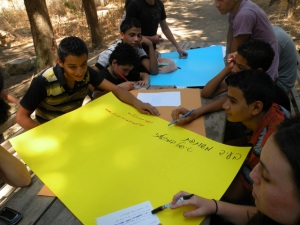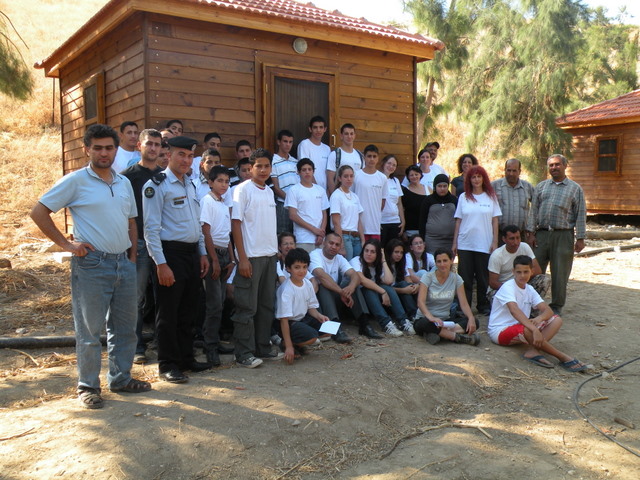
On June 30th in the afternoon groups from Tulkarem (Palestinian Authorities), Muaz bin Jabal (Jordan), Emek Hefer and Eshkol (Israel) arrive to FoEME’s Sharbabil Bin Hassneh EcoPark, located in the northen part of the Jordan Valley. This is the location where the camp will take place that is part of FoEME’s Community-GIS project. The park is accomodated with a dozen of brand new cabins, sleeping 50 people. All groups and their teachers are welcomed by Abu-Yazid, the camp manager, and Abdel Rahman Sultan (Abed), deputy director of FoEME’s Amman office. Abed takes the whole group on a tour around the park, focusing in particular on the issue of water. The students draw a map of all water resources in and around the park and the uses of the water.
The dam behind the camp creates a large reservoir with a capacity of four million cubic meters. However, in the past 10 years it has not reached its capacity level. Greywater from showers and bathroom sinks in the park is being separated from the sewage to be treated in a constructed wetland (yet to be completed) and reused for irrigation in the EcoPark. Black water from toilets is led through a septic tank before treatment. Other sources of water, such as seepage from the dam and water from taps in the dining area, are being diverted to a natural wetland, called Wadi Ziglab. This wetland provides a habitat to a number of species; submerged vegetation, insects and birds. Sometimes the wetland suffers from excessive blooming of algae, which leads to eutrophication of the water (the situation when the water acquires a high concentration of nutrients that stimulate excessive algae growth and may bring along bad smell among other things).

After sunset it is time for integration of the groups. Through social games and football all students get to know their peers who live on the other side of the border. First attempts are made to teach each other Hebrew or Arabic phrases.
The next day all students present their findings of the hazards threatening the environment in their communities and the surroundings, which they have been mapping in the first phase of the community-GIS project. Hazards caused by infrastructure, industry and agriculture range from air pollution and water pollution to bad odors. Subsequently, two workshops take place to discuss shared environmental problems and elaborate a campaign that could be implemented to raise awareness in their communities.
After the hard work during the morning it is time to cool down in the swimming pool of the neighbouring village Tabket Fahal. In the afternoon the bus is waiting to take all students and supervisors on a tour to the main water resources in Hima (The Yarmuk river). On the way the bus crosses the canal that diverts Jordan´s share of the Jordan river into the country. Unfortunately, Jordanian guards do not permit the group to enter the site of Hima. Quickly an alternative plan is drawn up and the bus heads to the village of Umm Qais. Here a tourist guide shows the group around at the Roman ruins of the ancient city of Gadara and the panoramic views on the Sea of Galilee, the Jordan Valley and the Golan Heights, including Mount Hermon. Hence, the site is also called Jabel Sheich – referring to the view on the four neighbouring countries (Jordan, Israel, Syria and Lebanon) and the sources of the Lower Jordan River shared by those four countries.
Back at the EcoPark everyone is pleasantly surprised by the visit of the mayor of North Shouneh (which includes also the villages of Muaz bin Jabal and Sharbil bin Husain), who welcomes everyone to Jordan and to the park. He emphasizes how important it is for Jordanians, Palestinians and Israelis to collaborate on important issues like environment and peace.
Day 3 starts with presentations by the students of the workshop results regarding their campaign planning. Finally, it is time for the very last part of the program; a visit to the impressive ruins of the 12th century Ajloun Muslim Castle is. The well informed tour guide explains the sophisticated water system used in the castle – from rain water harvesting, filtration, sewage water collection and drainage and even evidence of chemical semi-modern sewage treatment, perhaps the first in the world?
After exchanging contact details and saying goodbyes the Palestinian group, the Jordanian group and the Israeli groups each go their way. The joint camp has certainly given every participant new insights on environmental hazards, awareness raising and the importance of cross-border cooperation to establish peace and addressing shared problems.

This post was written by Efrath Silver, intern, and Youval Arbel, deputy director at FoEME’s Tel Aviv office.
Watch the video about the camp on FoEME’s YouTube channel and have a look at our Flickr page for more photo’s!
Related blog posts:
FoEME’s CGIS Teenagers Take Responsibility for their Shared Environment
175 Youth Celebrate Earth Day with FoEME in Jordan’s Sharhabil bin Hassneh EcoPark
